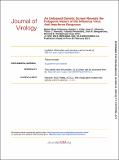An unbiased genetic screen reveals the polygenic nature of the influenza virus anti-interferon response
Abstract
Influenza A viruses counteract the cellular innate immune response at several steps, including blocking RIG I-dependent activation of interferon (IFN) transcription, IFN-dependent upregulation of IFN-stimulated genes (ISGs) and the activity of various ISG products; the multifunctional NS1 protein is responsible for most of these activities. To determine the importance of other viral genes in the interplay between the virus and the host IFN response, we characterised populations, and selected mutants, of wild type viruses selected by passage through IFN non-responsive cells. We reasoned that, by allowing replication to occur in the absence of the selection pressure exerted by IFN, the virus could mutate at positions that would normally be restricted and could thus find new optimal sequence solutions. Deep sequencing of selected virus populations and individual virus mutants indicated that non-synonymous mutations occurred at many phylogenetically conserved positions in nearly all virus genes. Most individual mutants selected for further characterisation induced IFN and ISGs and were unable to counteract the effects of exogenous IFN yet only one contained a mutation in NS1. The relevance of these mutations for the virus phenotype was verified by reverse genetics. Of note, several virus mutants expressing intact NS1 proteins exhibited alterations in the M1/M2 proteins and accumulated large amounts of deleted genomic RNAs, but nonetheless replicated to high titres. This suggests that the overproduction of IFN inducers by these viruses can override NS1-mediated IFN modulation. Altogether, the results presented suggest that influenza viruses replicating in IFN-competent cells have tuned their complete genomes to evade the cellular innate immune system and that serial replication in IFN non-responsive cells allows the virus to relax from these constraints and find new genome consensus within its sequence space. Importance In natural virus infections, the production of interferons leads to an antiviral state in cells that effectively limits virus replication. The interferon response places considerable selection pressure on viruses and they have evolved a variety of ways to evade it. Although the influenza virus NS1 protein is a powerful interferon antagonist, the contributions of other viral genes towards interferon evasion have not been well characterised. Here, we have examined the effects of alleviating the selection pressure exerted by interferon by serially passaging influenza viruses in cells unable to respond to interferon. Viruses that grew to high titres had mutations at many normally conserved positions in nearly all genes and were not restricted to the NS1 gene. Our results demonstrate that influenza viruses have fine tuned their entire genomes to evade the interferon response, and by removing interferon-mediated constraints, viruses can mutate at genome positions normally restricted by the interferon response.
Citation
Pérez-Cidoncha , M , Killip , M J , Oliveros , J C , Asensio , V J , Fernández , Y , Bengoechea , J A , Randall , R E & Ortín , J 2014 , ' An unbiased genetic screen reveals the polygenic nature of the influenza virus anti-interferon response ' , Journal of Virology , vol. 88 , no. 9 , pp. 4632-4646 . https://doi.org/10.1128/JVI.00014-14
Publication
Journal of Virology
Status
Peer reviewed
ISSN
0022-538XType
Journal article
Collections
Items in the St Andrews Research Repository are protected by copyright, with all rights reserved, unless otherwise indicated.

